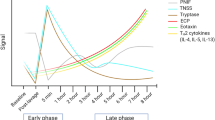Abstract
Objective
Increasing evidence suggests that leptin is upregulated during allergic reactions in the airway and related to the severity of disease in allergic rhinitis (AR). In this study, we aimed to investigate the expression of leptin during sublingual immunotherapy (SLIT) in AR patients.
Methods
Forty AR patients without obesity were recruited in this study. Twenty patients received house dust mite (HDM) allergen extract for SLIT and twenty patients received placebo randomly. Protein expression of leptin in serum and nasal lavage was tested by enzyme-linked immuno sorbent assay (ELISA) 1 and 2 years after SLIT treatment, respectively. Peripheral blood mononuclear cells (PBMCs) and human nasal epithelial cell were prepared and stimulated by recombinant leptin after 24 months’ SLIT treatment and the induction of Th2 cytokines (IL-4/IL-5/IL-13) were detected by ELISA.
Results
SLIT treatment decreased the expression of leptin protein in serum and nasal lavage significantly compared with placebo group 1 and 2 years after SLIT treatment. Nasal leptin level was correlated to decreased Th2 response (IL-4/IL-5/IL-13) and enhanced Treg (IL-10/TGF-beat) response after 2 years’ SLIT. We also found that SLIT decreased the ability of leptin in promoting Th2 cytokines expression by PBMCs and human nasal epithelial cell after 2 years’ SLIT treatment.
Conclusion
Changes of leptin expression in serum and nasal lavage may be correlated with Th2/Treg regulation during SLIT. Our results suggested that leptin served as an important biomarker during SLIT.


Similar content being viewed by others
References
Strachan D, Sibbald B, Weiland S et al (1997) Worldwide variations in prevalence of symptoms of allergic rhinoconjunctivitis in children: the International Study of Asthma and Allergies in Childhood (ISAAC). Pediatr Allergy Immunol 8:161–176
Ait-Khaled N, Anderson HR, Asher MI et al (2008) Worldwide time trends for symptoms of rhinitis and conjunctivitis: phase III of the International Study of Asthma and Allergies in Childhood. Pediatr Allergy Immunol 19:110–124
Hamouda S, Karila C, Connault T, Scheinmann P, de Blic J (2008) Allergic rhinitis in children with asthma: a questionnaire-based study. Clin Exp Allergy 38:761–766
Golden DBK (2000) Stinging insect vaccines. Immunol Allergy Clin North Am 20:553–570
Wilson AB, Deighton J, Lachmann PJ, Ewan PW (1994) A comparative study of IgG subclass antibodies in patient allergic to wasp or bee venom. Allergy 49:272–280
Conde J, Scotece M, Abella V, López V, Pino J, Gómez-Reino JJ et al (2014) An update on leptin as immunomodulator. Expert Rev Clin Immunol 10:1165–1170
Cohen S, Danzaki K, MacIver NJ (2017) Nutritional effects on T-cell immunometabolism. Eur J Immunol 47:225–235
Ciprandi G, Filaci G, Negrini S et al (2009) Serum leptin levels in patients with pollen-induced allergic rhinitis. Int Arch Allergy Immunol 148:211–218
Ciprandi G, De Amici M, Tosca MA, Marseglia G (2009) Serum leptin levels depend on allergen exposure in patients with seasonal allergic rhinitis. Immunol Invest 38:681–689
Brozek JL, Bousquet J, Baena-Cagnani CE, Bonini S, Canonica GW, Casale TB, van Wijk RG, Ohta K, Zuberbier T, Schünemann HJ, Global Allergy and Asthma European Network; Grading of Recommendations Assessment, Development and Evaluation Working Group (2010) Allergic rhinitis and its impact on asthma (ARIA) guidelines: 2010 revision. J Allergy Clin Immunol 126(3):466–476
Valovirta E, Jacobsen L, Ljorring C, Koivikko A, Savolainen J (2006) Clinical efficacy and safety of sublingual immunotherapy with tree pollen extract in children. Allergy 61:1177–1183
Irander K, Palm JP, Borres MP, Ghafouri B (2012) Clara cell protein in nasal lavage fluid and nasal nitric oxide-biomarkers with anti-inflammatory properties in allergic rhinitis. Clin Mol Allergy 6:4
Alvarez-Cuesta E, Bousquet J, Canonica GW, Durham SR, Malling HJ, Valovirta E, EAACI, Immunotherapy Task Force (2006) Standards for practical allergen-specific immunotherapy. Allergy 182:suppl:1–20
Frew AJ (2008) Sublingual immunotherapy. N Engl J Med 358:2259–2224
Guo Y, Li Y, Wang D, Liu Q, Liu Z, Hu L (2017) A randomized, double-blind, placebo controlled trial of sublingual immunotherapy with house-dust mite extract for allergic rhinitis. Am J Rhinol Allergy 31(4):42–47
Liu J, Hu X, Fu S, Wu C, Chen H, Zhang M (2014) Efficacy of individualized sublingual immunotherapy with dermatophagoides farinae drops on patients with allergic rhinitis of different age groups. J Clin Otorhinolaryngol, Head, Neck Surg 28(5):289–92
Hsueh KC, Lin YJ, Lin HC, Lin CY. Pediatr Allergy I (2010) Serum leptin and adiponectin levels correlate with severity of allergic rhinitis. Pediatric Allergy Immunol 21(1 Pt 2):e155–9
Ciprandi G, De Amici M, Tosca M, Negrini S, Murdaca G, Marseglia GL (2009 Sep) Two year sublingual immunotherapy affects serum leptin. Int Immunopharmacol 9(10):1244–1246
Miller A (2011) Role of LEPTIN in inflammation and disease. J Inflammation (8)(1):22
Author information
Authors and Affiliations
Corresponding author
Ethics declarations
Conflict of interest
All authors declares that they have no conflicts of interest.
Ethical approval
All procedures performed in studies involving human participants were in accordance with ethical standards of the institutional and/or national research committee and with 1964 Helsinki declaration and its later amendments or comparable ethical standards.
Rights and permissions
About this article
Cite this article
Wen, Y., Zhou, L., Li, Y. et al. Role of leptin in allergic rhinitis during sublingual immunotherapy. Eur Arch Otorhinolaryngol 275, 2733–2738 (2018). https://doi.org/10.1007/s00405-018-5123-0
Received:
Accepted:
Published:
Issue Date:
DOI: https://doi.org/10.1007/s00405-018-5123-0




